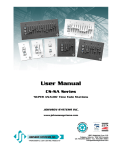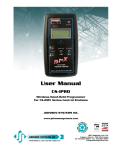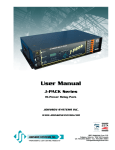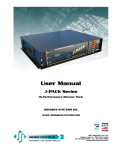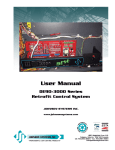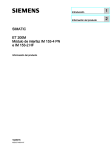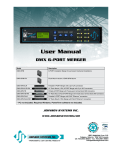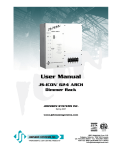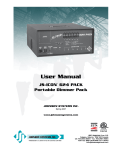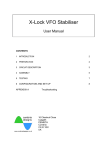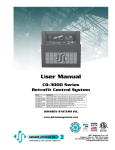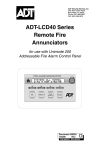Download User Manual - Johnson Systems Inc.
Transcript
User Manual CS-DMX Series Programmable Manual DMX Stations JOHNSON SYSTEMS INC. www.johnsonsystems.com Contents Warranty...........................................................................................................2 User Manual Copies.........................................................................................2 Introduction.......................................................................................................3 Features...........................................................................................................3 CS-DMX Series Control Station Diagrams.......................................................4 “ON”, “DIM” and “OFF” Buttons with Integral LED’s.........................................5 Master (M) Slider..............................................................................................5 Secondary (3, 6, 9 or 12) Sliders......................................................................5 Control Station Security Feature......................................................................5 Power Supply Requirement..............................................................................6 Control Station Wiring......................................................................................6 DMX Input and Output Wiring..........................................................................6 Wiring an Independent Control Station............................................................7 Wiring a Single or Multiple Entrance Control Stations to a Master Control Station...............................................................................7 Wiring Two or More Master Control Stations Together with “Take Control”......7 Wiring Two or More Control Stations Together with “Mimic”.............................8 Mounting the Control Station............................................................................8 Calibrate the DMX Output Range.....................................................................8 Configure the Control Station Using a CS-IPRO Wireless Hand-Held Programmer...................................................................................8 Time Fade........................................................................................................9 Set the Adjustable Time Fade..........................................................................9 Set the Button LED Intensity............................................................................9 Local Lockout Mode Activation.......................................................................10 Remote Lockout Mode Activation...................................................................10 Short Circuit and Overload Protection............................................................10 CS-DMX Series Typical Wiring Applications...................................................11 Warranty All CS-DMX Series control stations come with a standard one (1) year limited warranty against defects in parts and workmanship. User Manual Copies Additional copies of the most recent version of this manual can be downloaded at: http://www.johnsonsystems.com/pdf_files/jsi_cs_dmx_manual_rev_1.pdf. Note: Refer to the CS-IPRO user manual for detailed programming information. 2 www.johnsonsystems.com Introduction Multi-Station, multi-room manual DMX controls for a full DMX universe of control! CS-DMX Series Programmable Manual DMX Station Value, power and complete flexibility in a “green”, user friendly, cost-effective package! The DMX Series of controls are the most capable manual “stand-alone” DMX controls available. These field programmable controls support 512 channels of DMX data with digitally adjustable fade times. Multiple stations can be daisy-chained together on the same control wire permitting multiple stations per room. Each station can be individually programmed with our wireless infrared hand-held programmer (Model Number: CS-IPRO) permitting any slider/channel assignments imaginable. Available from single to 12 channels with master, preset and take control functions. Two and three button entrance station can be remotely “locked out” for application where access needs to be limited. This series of controls will operate on DC supply voltages up to 18 volts. Adjustable time fade and LED intensity allow customization for demanding applications. Durable powder-coat finish is available in either black or white. CS-IPRO Wireless Hand-held Programmer Features • Manual DMX at your fingertips. • Six models/sizes available including two and three button entrance stations. • 512 DMX channels of control per station. • Multiple stations can be daisy-chained on the same DMX line. • Digitally adjustable fade-times and LED brightness. • Station programming via low cost, wireless infrared hand-held remote. • Local or remote/entrance station lockout options. • Short-circuit and over-current protection. • Ruggedly built for reliability and longevity. • Tough, durable powder coat paint on 0.080” aluminum laser cut faceplate for a scratch resistant non-glare finish. • Color matched and sized for use with Johnson Systems AP Series adapter plates where necessary to adapt to existing (larger) electrical back boxes. • Metal shaft sliders and machine screw mounting help prevent broken or missing parts. • Heavy-duty "high tactile" pushbutton switches are rated for 5 million operations. • Optional 6 Port Cascading Installation Merger permits low cost DMX universe combining. www.johnsonsystems.com 3 CS-DMX Series Control Station Diagrams "ON", "DIM", and "OFF" Buttons With Integral LED's Master (M) Slider Infared LED Sensor Secondary (3, 6, 9, or 12) Sliders 6-Position Connector (J1) For: • Power Supply Input (COM, V+) • Button Contacts (ON, DIM, RST) • Master Pot (MP) Analog Output DMX Output Range Calibration Jumper (JP1) Security Enable/Disable Jumper (JP2) Factory Only Jumper(s) DMX Input Connector (J1) DMX Output Connector (J2) DMX Termination Jumper (JP1) 4 www.johnsonsystems.com “ON”, “DIM” and “OFF” Buttons with Integral LED’s All CS-DMX Series control stations contain 3 buttons with integral blue LED’s. When a button is pressed, the control station is triggered into the corresponding state. The button LED’s indicate the state of the control station. Under normal operation, when a button is pressed, the corresponding LED will illuminate. If the control station is fading, the LED will flash once per second until the fade is complete. Pressing a button or adjusting the master slider level while the control station is fading, cancels the fade and immediately activates the button pressed. The button LED’s also indicate when local or remote lockout is active, or if there is a short-circuit or overload condition (refer to page 10 for details). The intensity of the button LED’s can be adjusted (refer to “Set the Button LED Intensity” on page 9). Pressing the “ON” button triggers all of the DMX channels patched to the sliders to full on. The “ON” button corresponds with the “ON” connection on J1 and is optionally connected to other control stations for various applications. Pressing the “DIM” button activates DMX output control from the slider potentiometers (pots). The “DIM” button corresponds with the “DIM” connection on J1 and is optionally connected to other control stations for various applications. Pressing the “OFF” button turns off (zero percent (00%) output level) all of the DMX channels patched to the sliders. The “OFF” button corresponds with the “RST” (reset) connection on J1 and is optionally connected to other control stations for various applications. NOTE: The control station will still transmit DMX output levels at zero percent (00%) in the “OFF” state. Master (M) Slider The master slider controls the overall maximum DMX output level for the secondary sliders. It has similar functionality to a grand master slider found on some DMX control consoles. Secondary (3, 6, 9 or 12) Sliders Each of the secondary sliders control the DMX output level for all the DMX channels patched to the slider. Each slider can be configured to control any combination of 512 DMX channels. Control Station Security Feature All CS-DMX Series control stations have the capability to enable or disable the security feature. Once security is enabled, the security key programmed in the control station must match the security key in the CS-IPRO programmer, to be able to make programming changes to the control station. The security feature eliminates the possibility for tampering with the control station programming. The security feature is disabled by factory default. If the security feature is required, it should be implemented at the time of installation. To enable the security feature, set the SECURITY jumper (JP2) in the ENABLE position. Once installation of the CS-DMX control station is completed, refer to the CS-IPRO user manual SECURITY menus (EDIT KEY, SET KEY and GET KEY) for detailed programming and setup information. The default 8-digit security key for all CS-DMX Series control stations is set at all zeros (00000000). www.johnsonsystems.com 5 Power Supply Requirement The control station requires a regulated DC power supply from 10.6VDC to 18VDC. A 12VDC power supply is recommended. The power supply common (V-) connects to the “COM” connection on J1 and the power supply positive (V+) connects to the “V+” connection on J1. Control Station Wiring CS-DMX Series control stations can be wired for various applications. The control station wiring can be configured for the functionality required. A 6-position breakaway connector (J1) is used to connect the power supply (COM, V+), three switches (ON, DIM, RST), as well as the master pot (MP) analog output (not used with CS-DMX Series control stations). The recommended wire for these connections is stranded, #18 AWG copper wire, however smaller gauge wire may be suitable for some applications where distances are less than 150' (50m). The breakaway connector will accept wire sizes from #28 to #12 AWG. Breakaway connectors are provided for all wiring terminations. For proper termination, the strip length should be 0.28" (7mm). A 1/8" (3.2mm) flat head screwdriver should be used to tighten the connections and torque to 3.5Lb-In (0.4Nm). DMX Input and Output Wiring All CS-DMX Series have a 3-position breakaway connector used to receive DMX in (DMX IN) and a 3-position breakaway connector used to transmit DMX out (DMX OUT). The DMX received on the DMX in (if applicable) connector is merged with the DMX generated by the control station and retransmitted through the DMX out connector. Merged DMX data is highest takes precedence (HTP) for equivalent DMX control channels. There is only a 1-packet (28msec) delay in the retransmitted DMX from the original DMX received! For proper termination, the strip length should be 0.28" (7mm). A 1/8" (3.2mm) flat head screwdriver should be used to tighten the connections and torque to 3.5Lb-In (0.4Nm). Be sure to isolate and protect all shield wires and comply with standard RS-485 termination practices. • DMX IN (SHIELD/COMMON, DATA-, DATA+) is terminated on the J1 connector. • DMX OUT (SHIELD/COMMON, DATA-, DATA+) is terminated on the J2 connector. • Complies with USITT DMX512-A (ANSI E1.11 - 2008), standard protocol for digital data control. • Recommended cable is Beldon 9829, 9842, Cat 5 or equivalent (low-capacitance, twisted pair). • Wiring must follow a daisy-chain topology. • Maximum of 32 receiving devices on a single DMX line. • Maximum cable length is 1,500 feet (455 meters). • For more information, Google DMX, or visit: http://www.usitt.org/DMX512FAQ.aspx NOTE: For long DMX lines exceeding 1,000 feet (305 meters) the “DMX TERM” jumper (JP1) should be in the terminated (upper) position. NOTE: Be sure the last DMX receiving device (end-of-line) is terminated with a 100Ω to 120Ω resistor. 6 www.johnsonsystems.com Wiring an Independent Control Station An independent control station requires 2 conductors for V+ and common, and a single DMX cable for the DMX out connection. CS-DMX-12 COM DC POWER SUPPLY COMMON (V-) INPUT V+ DC POWER SUPPLY POSITIVE (V+) INPUT DMX OUT Wiring a Single or Multiple Entrance Control Stations to a Master Control Station An entrance control station (Part Numbers: CS-SA-ENT2B and CS-SA-ENT3B) is typically installed at an entrance location and used to trigger a master control station into the “ON”, “DIM” or “OFF” state. The entrance station(s) and master station mimic each other when a button is pressed. Wiring between a single or multiple entrance stations and master station requires 2 conductors for V+ and common, and 3 conductors for the switches (ON, DIM and RST), 1 conductor for each switch function. A single DMX cable is required from the master control station to the DMX receiving device. CS-SA-ENT3B CS-SA-ENT3B COM COM COM COM ON ON ON ON V+ DIM RST V+ V+ DIM DIM RST RST CS-DMX-12 COM V+ V+ DIM DC POWER SUPPLY COMMON (V-) INPUT DC POWER SUPPLY POSITIVE (V+) INPUT RST DMX OUT CS-SA-ENT2B CS-SA-ENT2B CS-DMX-12 COM COM COM COM ON ON ON ON V+ RST V+ V+ RST RST COM V+ V+ RST DC POWER SUPPLY COMMON (V-) INPUT DC POWER SUPPLY POSITIVE (V+) INPUT DMX OUT Wiring Two or More Master Control Stations Together with “Take Control” When two or more master control stations are controlling the same device (DMX channels), “take control” is typically required. When a button is pressed on one of the master control stations, it will automatically “take control” from the other master control stations and put them in the “OFF” state. Wiring between the master control stations requires 2 conductors for V+ and common, and 1 conductor for reset (RST) “take control”. A DMX cable between the control stations is required, along with a DMX cable from one of the master control stations to the DMX receiving device. CS-DMX-12 CS-DMX-12 COM COM RST RST V+ DMX OUT V+ COM V+ DMX IN www.johnsonsystems.com DC POWER SUPPLY COMMON (V-) INPUT DC POWER SUPPLY POSITIVE (V+) INPUT DMX OUT 7 Wiring Two or More Control Stations Together with “Mimic” “Mimic” refers to pressing a button (“ON”, “DIM” or “OFF”) on a control station, and the other control station(s) are automatically triggered into the same “ON”, “DIM” or “OFF” state. The analog output(s) could be controlling the same device or completely different device. Wiring between the control stations requires 2 conductors for V+ and common, and 3 conductors (2 conductors for Part Number: CS-SA-ENT2B) for the switches (ON, DIM and RST), 1 conductor for each switch function. A DMX cable between the control stations is required, along with a DMX cable from one of the master control stations to the DMX receiving device. CS-DMX-12 COM COM ON ON V+ DIM RST DMX OUT CS-DMX-12 V+ COM V+ DIM DC POWER SUPPLY COMMON (V-) INPUT DC POWER SUPPLY POSITIVE (V+) INPUT RST DMX IN DMX OUT Mounting the Control Station The control station can be mounted on/in a gangable (usually masonry) type of back box with a minimum depth of 2" (50.8mm) and a preferred depth of 3.5" (88.9mm). A #2 Phillips head screwdriver is required to secure the control station, using the provided black #6-32 x 1" (25.4mm) mounting screws. NOTE: Ensure the back box is earth grounded to protect the control station from electrostatic discharge. NOTE: Ensure the back box mounting-hole threads are not damaged. Damaged threads on the back box can damage the threads on the mounting screws and cause stripping. The back box threads can quickly be cleaned up by running a #6-32 tap through the mounting hole. Be sure not to over-tighten the mounting screws or this could result in stripping the back box mounting-hole threads. Calibrate the DMX Output Range All CS-DMX Series control stations are factory calibrated for 0-100% DMX control with a 10.6VDC to 18VDC power supply. If the control station does not have a full range of DMX control, please consult a factory representative. Configure the Control Station Using a CS-IPRO Wireless Hand-Held Programmer To configure the control station, a Johnson Systems Inc. Model Number: CS-IPRO wireless handheld programmer is required. The CS-IPRO is required primarily to configure the DMX channel patch for each of the sliders, however, it provides several other useful features. Wireless communication between the CS-IPRO and CS-DMX Series control stations is via bidirectional infrared LED’s. The control station infrared LED window is located between the master (M) slider and slider 1. The maximum range for sending and receiving data between the control station and CS-IPRO is 12" (30cm). NOTE: Refer to the CS-IPRO user manual for detailed programming information. 8 www.johnsonsystems.com Time Fade The control station is capable of fading from: “OFF” “ON” “ON” “OFF” “OFF” “DIM” “DIM” “OFF” The control station is capable of pseudo fading from: “DIM” “ON” “ON” “DIM” The control station automatically begins fading when a button is pressed. The button LED flashes on and off once per second to indicate fading. NOTE: Pressing a button or adjusting the master slider level while the control station is fading, cancels the fade and immediately activates the button pressed. Set the Adjustable Time Fade The time fade can be adjusted from 0 to 60 seconds. The factory default time fade is 5 seconds. NOTE: Be sure the local and remote lockout modes are deactivated before adjusting the time fade. Procedure: • To set the adjustable time fade, press and hold the “ON” button for approximately 10 seconds, until the “ON” LED extinguishes. • Release the “ON” button and count the number of times the “ON” LED flashes on. Each time the “ON” LED flashes on, 1 second of time fade is represented. • Once the required number of times the “ON” LED flashes on is counted, press the “ON” button to save the time fade and exit. • To set the time fade to zero (no fading), press and hold the “ON” button for approximately 10 seconds, until the “ON” LED extinguishes. Release the “ON” button and immediately press the “ON” button again before the “ON” LED flashes on. Set the Button LED Intensity The button LED intensity can be adjusted to a preferred intensity level for various environments. NOTE: Be sure the local and remote lockout modes are deactivated before adjusting the button LED intensity. Procedure: • To enter the button LED intensity adjust mode, press and hold the “ON” and “OFF” buttons at the same time for approximately 10 seconds, until all the button LED’s illuminate. • Press the “ON” button to increase the button LED intensity. Press and hold the “ON” button to accelerate the intensity adjustment. • Press the “OFF” button to decrease the button LED intensity. Press and hold the “OFF” button to accelerate the intensity adjustment. • Once the preferred button LED intensity has been set, press the “ON” and “OFF” buttons at the same time to exit the button LED intensity adjust mode and save the setting. NOTE: There is a minimum button LED intensity so the control station will always indicate its mode of operation/state. www.johnsonsystems.com 9 Local Lockout Mode Activation When the local lockout mode is activated, the control station is locked in the “OFF” state. Any button press is ignored and the “OFF” LED flashes once to indicate local lockout mode is activated. Procedure: • To activate the local lockout mode, press and hold the “OFF” button for approximately 10 seconds, until the “OFF” LED extinguishes. • To deactivate the local lockout mode, press and hold the “OFF” button for approximately 10 seconds, until the “OFF” LED illuminates. Remote Lockout Mode Activation When the remote lockout mode is activated, the control station ignores all remote control station key presses. The active LED flashes off for 0.1 seconds every 2 seconds to indicate remote lockout mode is activated. Procedure: • To activate the remote lockout mode, press and hold the “DIM” button for approximately 10 seconds, until the “DIM” LED flashes off for 0.1 seconds. • To deactivate the remote lockout mode, press and hold the “DIM” button for approximately 10 seconds, until the “DIM” LED flashes off for 0.1 seconds. Short Circuit and Overload Protection The control station is equipped with short circuit and overload protection. The short circuit limit is set at 100mA with 0.6W of power dissipation. When a short circuit or overload is detected while in the “ON” or “DIM” state, all of the button LED’s flash on and off to indicate there is a short circuit or overload condition. The control station automatically recovers to normal operational state once the short circuit or overload is removed. 10 www.johnsonsystems.com CS-DMX Series Typical Wiring Applications www.johnsonsystems.com 11 CS-DMX Series Programmable Manual DMX Stations Model Description # Wires Back Box Minimum PCB Clearance 1 gang, 3 channel manual control w/master slider, on, preset, and off 2 x #18 AWG +DMX CS-DMX-3-? 2 gang 3.60"W x 2.75"H x 2.00"D 9.1cm x 7.0cm x 5.1cm CS-DMX-6-? 2 gang, 6 channel manual control w/master slider, on, preset, and off 2 x #18 AWG +DMX 3 gang 5.50"W x 2.75"H x 2.00"D 14.0cm x 7.0cm x 5.1cm CS-DMX-9-? 3 gang, 9 channel manual control w/master slider, on, preset, and off 2 x #18 AWG +DMX 4 gang 7.30"W x 2.75"H x 2.00"D 18.5cm x 7.0cm x 5.1cm CS-DMX-12-? 4 gang, 12 channel manual control w/master slider, on, preset, and off 2 x #18 AWG +DMX 5 gang 9.10"W x 2.75"H x 2.00"D 23.1cm x 7.0cm x 5.1cm CS-SA-ENT2B-? 1 gang, 2 button (on/off) entrance station with adjustable “on” voltage for stand-alone applications 5 x #18 AWG 1 gang 1.80"W x 2.75"H x 2.00"D 4.6cm x 7.0cm x 5.1cm CS-SA-ENT3B-? 1 gang, 3 button entrance station w/on, preset, and off 6 x #18 AWG 1 gang 1.80"W x 2.75"H x 2.00"D 4.6cm x 7.0cm x 5.1cm CS-IPRO Hand-held Infrared Station Programmer Wireless N/A N/A DMX-6PIM DMX 6 Port (6IN/1OUT) Cascading Merger 120VAC + 7 DMX or CAT5E Wall Mount or Flush Mount N/A 2.75"W x 4.95"H x 1.00"D (70cm x 125cm x 25cm) 9.5"W x 12"H x 3.5"D (24cm x 30cm x 9cm) For other control products and solutions please visit WWW.JOHNSONSYSTEMS.COM User Manual CS-DMX Series Programmable Manual DMX Stations Rev. 1 www.johnsonsystems.com












